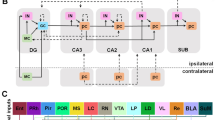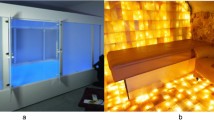We report studies of the neuroendocrine mechanisms of development of an anxiety state in rats using the “stress-restress” experimental model of post-traumatic stress disorder. Immunocytochemical methods demonstrated significant increases in corticoliberin expression in both the parvo- and magnocellular parts of the paraventricular nucleus persisting to 10 days after presentation of the animals with repeated stress. Decreases in vasopressin expression were seen in the paraventricular nucleus of the animals on the first day after repeated stress. Vasopressin contents in the parvocellular part of the nucleus in animals of the experimental group were no different at 10 days from those in animals of the control group, while levels in the magnocellular part were increased. These data provide evidence for the involvement of the hypothalamic component of the vasopressinergic system (along with the corticoliberinergic system) in the pathogenetic mechanisms of the analog of post-traumatic stress disorder generated in this model.
Similar content being viewed by others
References
V. M. Voloshin, Post-Traumatic Stress Disorder. Phenomenology, Clinical Aspects Systematics, Dynamics, and Contemporary Approaches to Psychopharmacotherapy [in Russian], Anakharsis, Moscow (2005).
A. L. Pushkarev, V. A. Domoratskii, and E. G. Gordeeva, Post- Traumatic Stress Disorder: Diagnosis, Psychopharmacotherapy, Psychotherapy [in Russian], Institute of Psychotherapy Press, Moscow (2000).
M. V. Ugryumov, Mechanisms of Neuroendocrine Regulation [in Russian], Nauka, Moscow (1999).
V. G. Shalyapina, “Corticoliberin in the regulation of adaptive behavior in the pathogenesis of post-stress depression,” in: Basic Neuroendocrinology [in Russian], V. G. Shalyapina and P. D. Shabanov (eds.), ÉLBI, St. Petersburg (2005), pp. 84–146.
K.-B. Abel and J. A. Majzoub, “Molecular biology of the HPA axis,” in: Handbook of Stress and the Brain, T. Steckler, N. H. Kalin, and J. M. H. M. Reul (eds.), Elsevier, Amsterdam (2005), pp. 79–95.
G. Aguilera and C. Rabadan-Deihl, “Vasopressinergic regulation of the hypothalamic-pituitary-adrenal axis: implications for stress adaptation,” Regul. Pept., 96, 23–29 (2000).
R. H. Belmaker and G. Agam, “Major depressive disorder: mechanisms of disease,” New. Engl. Med. J., 358, No. 1, 55–68 (2008).
G. D. Bremner, I. Licono, and A. Darnell, “Elevated corticotropinreleasing factor concentration in posttraumatic stress disorders,” Am. J. Psychiatry, 154, No. 5, 624–629 (1997).
C. S. de Kloet, E. Vermetten, E. Geuze, E. G. Lentjes, C. J. Heijnen, G. K. Stalla, and H. G. Westenberg, “Elevated plasma corticotrophin- releasing hormone levels in veterans with posttraumatic stress disorder,” Prog. Brain Res., 167, 287–291 (2007).
C. S. De Kloet, E. Vermetten, C. J. Heijnen, E. Geuze, E. G. Lentjes, and H. G. Westenberg, “Enhanced cortisol suppression in response to dexamethasone administration in traumatized veterans with and without posttraumatic stress disorder,” Psychoneuroendocrinology, 32, No. 3, 215–226 (2007).
E. B. De Souza and D. E. Grigoriadis, “Corticotropin-releasing factor: physiology, pharmacology, and role in central nervous system disorders,” in: Neuropsychopharmacology: The Fifth Generation of Progress, K. L. Davis, J. T. Charney, J. T. Coyle, and C. Nemeroff (eds.), American College of Neuropsychopharmacology (2002), Chapter 7, pp. 91–107.
A. J. Douglas, “Vasopressin and oxytocin,” in: Handbook of Stress and the Brain. Part 1. The Neurobiology of Stress, N. H. Steckler, N. H. Kalin, and J. M. H. M. Reul (eds.), Elsevier, Amsterdam, etc. (2005), pp. 205–230.
B. H. Harvey, C. Naciti, L. Brand, and D. J. Stein, “Endocrine, cognitive and hippocampal/cortical 5HT1A/2A receptor changes evoked by a time-dependent sensitisation (IDS) stress model in rats,” Brain Res., 983, 97–107 (2003).
F. Holsboer, “Corticotropin-releasing hormone modulators and depression,” Curr. Opin. Investig. Drugs, 4, 46–50 (2003).
F. Holsboer, “Neuroendocrinology of mood disorders,” in: Psychopharmacology: the Fourth Generation of Progress, F. E. Bloom and D. J. Kupfer (eds.), Raven Press, New York (1995), Chapter 83, pp. 957–970.
J. W. Kaskow, D. Baker, and T. D. Geracioti, “Corticotropin-releasing hormone in depression and post-traumatic stress disorder,” Peptides, 22, 845–851 (2001).
I. Liberzon, M. Krstov, and E. A. Young, “Stress-restress: effects on ACTH and fast feedback,” Psychoneuroendocrinology, 26, 443–453 (1997).
M. Olff, Y. Güzelcan, G. J. De Vries, J. Assies, and B. P. Gersons, “HPA- and HPT-axis alterations in chronic posttraumatic stress disorder,” Psychoneuroendocrinology, 31, No. 10, 1220–1230 (2006).
M. A. Oquendo, G. Echavarria, H. C. Galfalvy, M. F. Grunebaum, I. Burke, A. Barrera, T. B. Cooper, K. M. Malone, and J. J. Mann, “Lower cortisol levels in depressed patients with comorbid posttraumatic stress disorder,” Neuropsychopharmacology, 28, 591–598 (2003).
M. Owens and C. B. Nemeroff, “Physiology and pharmacology of corticotropin-releasing factor,” Pharmacol. Rev., 43, No. 4, 425–473 (1991).
P. H. Rosebloom, N. H. Kalin, T. Steckler, and F. M. Dautzenberg, “Molecular regulation of the CRF system,” in: Handbook of Stress and the Brain. Part 1. The Neurobiology of Stress, T. Steckler, N. H. Kalin, and J. M. H. M. Reul (eds.), Elsevier, Amsterdam, etc. (2005), Vol. 15, pp. 133–152.
L. Scott and T. G. Dinan, “Vasopressin as a target for antidepressant development: an assessment of available evidence,” J. Affect. Disord., 72, 113–124 (2002).
D. Simeon, M. Knutelska, R. Yehuda, F. Putnam, J. Schmeidler, and L. M. Smith, “Hypothalamic-pituitary-adrenal axis function in dissociative disorders, post-traumatic stress disorder, and healthy volunteers,” Biol. Psychiatry, 61, No. 8, 966–973 (2007).
G. N. Smagin, S. C. Heinrics, and A. J. Dunn, “The role of CRH in behavioral responses to stress,” Peptides, 22, 713–724 (2001).
J. D. K. Uys, D. J. Stein,W. M. U. Daniels, and B. H. Harvey, “Animal models of anxiety disorders,” Curr. Psychiat. Rep., 5, 274–281 (2003).
L. Weisaeth, “Vulnerability and protective factors for posttraumatic stress disorder,” Psychiat. Clin. Neurosci., 52, No. 5, 83–88 (1998).
R. Yehuda, “Advances in understanding neuroendocrine alterations in PTSD and their therapeutic implications,” Ann. N.Y. Acad. Sci., 1071, 137–156 (2006).
R. Yehuda and S. M. Antelman, “Criteria for evaluating animal models of post traumatic stress disorder,” Biol. Psychiat., 33, 479–486 (1993).
Author information
Authors and Affiliations
Corresponding author
Additional information
Translated from Rossiiskii Fiziologicheskii Zhurnal imeni I. M. Sechenova, Vol. 94, No. 11, pp. 1277–1284, November, 2008.
Rights and permissions
About this article
Cite this article
Mironova, V.I., Rybnikova, E.A. Stable Modifications to the Expression of Neurohormones in the Rat Hypothalamus in a Model of Post-Traumatic Stress Disorder. Neurosci Behav Physi 40, 111–115 (2010). https://doi.org/10.1007/s11055-009-9216-5
Received:
Revised:
Published:
Issue Date:
DOI: https://doi.org/10.1007/s11055-009-9216-5




